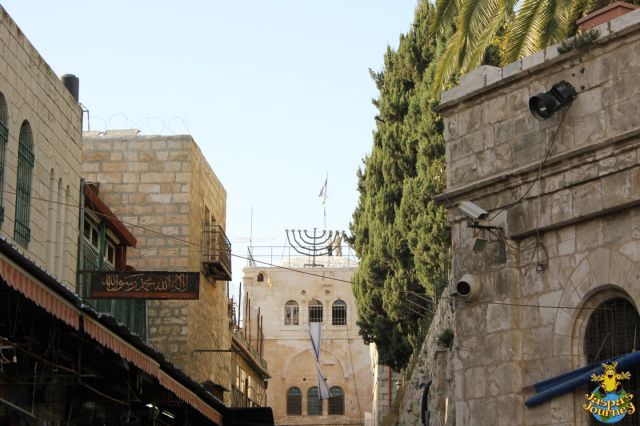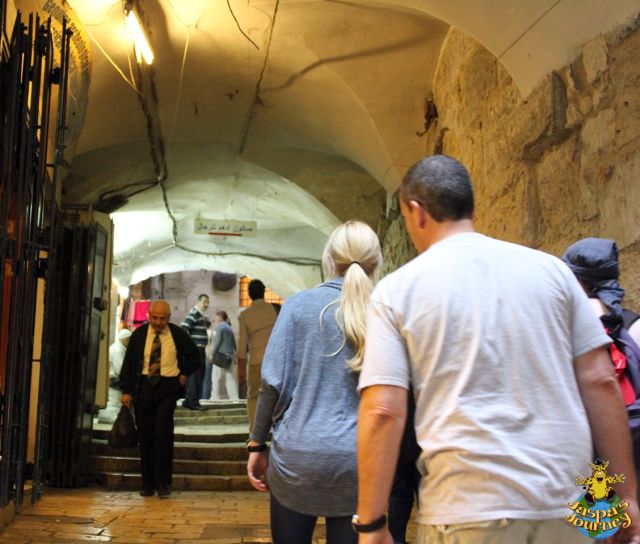You don’t have to be a religious person to be moved by Via Dolorosa, the Way of Sorrows. The route through the alleyways of Old Jerusalem is said to mark the path taken by Jesus Christ from where he was tried and collected his cross, to the spot on Calvary hill where he was executed and buried.
From what I’ve read, today’s Via Dolorosa is more symbolic than factual. The ‘official’ route through the Old City has varied significantly over the last 2000 years. As such, the physical locations of many of the individual Stations of the Cross along the current way have no historical connection to the events they represent. In fact, historians say that at least some of the events took place in a completely different part of the city.
But that hardly seems the point at this stage. Each year thousands of people walk the Via Dolorosa, believers and non-believers alike.

The Monastery of the Flagellation: Stations 1 & 2, representing where Jesus was tried, given his cross and presented to the crowd by Pontius Pilate (historians now believe Christ was actually tried in Herod’s Palace on the opposite side of the Old City)

All that is still visible of the triple-arched Ecce Homo Arch, where Pilate said “Behold the Man” (Station 2)

Station 4 represents where Jesus met his mother, Mary:
Note the carvings depicting the events of Stations 3 (left) and 4 (above the doorway on the right)

The Roman Catholic altar on the Rock of Golgotha (Calvary), inside the Church of the Holy Sepulchre, marks Stations 10 (where Jesus was stripped) and 11 (where he was nailed to the cross)

The Rock of Golgotha’s Greek Orthodox altar stands above Station 12, believed to be the spot where Jesus was crucified (the people kneeling beneath the altar are touching the rock itself)

Station 13, where Jesus’s body is said to have been anointed before burial (the stone in this photo dates from the 18th Century)

Station 14, Jesus’s Tomb: originally a simple cave, the hillside was removed in the 4th Century, so the first church could be built around the tomb
This post was inspired by the photo themes of Alleys from Cee’s Fun Foto Challenge, Signs from Nancy of Nancy Merrill Photography and Jo’s Monday Walk.
If you’re the sort of person that loves delving into history on your travels, why not sign up and follow my continuing Journeys here at Jaspa’s Journal (on WordPress or Bloglovin’), or through my website, Facebook, Twitter, Instagram and Tumblr?
And if that’s not enough for you, the first Jaspa’s Journey adventure, The Great Migration, is now available in both paperback and ebook formats from Amazon and other online booksellers! The first two sequels are scheduled to be released by Speaking Volumes later this year.
Jaspa’s Journey: Perfect for Kids 8 – 80!

























Thanks for sharing, Jaspa. 🙂 It’s fascinating to walk in His steps.
You’re welcome, Jo.
Great photos and tour for this week. Thanks 😀
Thanks, Cee!
What a wonderful journey, Jaspa! Thanks for including my challenge!
My pleasure, Nancy!
I’m not religious but I’d love to go to Jerusalem. Thanks for sharing these lovely scenes.
I agree with you, Jude. I’m not religious either, but I love going to historic places like Jerusalem. I hope I get to go back for a longer visit one day.
I walked this road years ago. Good to see these photos. Thank you for posting.
Happy it brought back memories, Helen.
Pingback: Jo’s Monday walk : Seal sanctuary | restlessjo
è sempre con immensa commozione che rivivo questi luoghi sacri, qui inrensamente documentati
grazie mille
Non c’è di che!
(I hope that’s correct 🙂 )
sì, corretto! buon italiano 🙂
A fascinating trip. Thank you, Jaspa for sharing.
I just count myself lucky to have been, Paula.
Pingback: Verwaarloosde geboortedag en sterfplaats 3 Oog voor de Grafkerk | Bijbelvorser = Bible Researcher